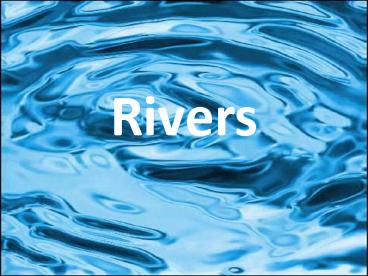Rivers - PowerPoint PPT Presentation
1 / 13
Title:
Rivers
Description:
What are some ways in which riverbank erosion can be ... keep water from moving naturally Global warming/climate change Flood Protection People in southern ... – PowerPoint PPT presentation
Number of Views:74
Avg rating:3.0/5.0
Title: Rivers
1
Rivers
2
- As rivers carve across the land they not only
provide water and habitats for special
ecosystems, they change the land itself. As water
flow they - ERODE the land. In Winnipeg, the erosion of
riverbank property is a huge concern. What are
some ways in which riverbank erosion can be
reduced? - Control river levels
- line river banks with concrete/rocks
- Divert water (floodway)
- Slowing boats no wake zones
- Plant trees/shrubs on banks
- Create unique landforms such as peninsulas
(land surrounded by water on three sides) as the
river MEANDERS or wanders. The water eroding
softer land causes this.
3
Oxbow Lakes
- Create an OXBOW LAKE which is a U-shaped lake
or pond formed when a rivers meander is cut off
from the river.
4
Oxbow Step 1
Deposition occurs on the inside edge where water
flows slower
Outside edge erodes as water hits it hard
5
Oxbow Step 2
More sediments are deposited in old channel
New channel begins to form
6
Oxbow Step 3
Old meander is left as an Oxbow Lake
Old channel is completely cut off
7
River Deltas
- Creates ALLUVIAL DEPOSITS and DELTAS as the water
deposits the minerals it eroded on its journey.
Deltas are fan-shaped land forms found at the
mouth of rivers (where the river meets a lake,
sea, or ocean). The NILE River Delta may be one
of the most famous river deltas in the world and
was and is important to Egyptian life. - Draw a triangle around the green delta area
formed when the Nile deposits the rich, fertile
sediments eroded from the African continent.
8
River Deltas
- This land is FERTILE and productive
agriculturally! - Delta (?) is the Greek letter D and is in the
shape of a triangle! - In Manitoba the rivers flowing into Lake Winnipeg
and Lake Manitoba form marshy deltas, areas that
are important for - Wildlife habitat (both land and aquatic)
- Cleaning/purifying water entering the lakes
9
Old vs. Young Rivers
10
Old vs. Young Rivers
- Use the table below to compare and contrast young
and old rivers.
YOUNG OLD
Fast Slow
Straighter Windy (meandering)
Energetic Less energy
Can move large boulders Move small sediments
Narrower Wider
Cleaner water More sediment/ muddier
11
The RED River
- As the Red River began only after Lake Agassiz
drained some 10000 years ago, it is considered to
be a young river. But it behaves like an older
river because it has a low flow rate with little
energy! - The areas on the sides of the river create a
river valley or a flood plain. The Red Rivers
flood plain is wide and shallow, much like a
gentle plate. - This creates many problems with flooding.
12
The RED River Flooding
- Other factors leading to flooding in southern
Manitoba include
Flat, wide flood plain Slow flow
Flows north mouth is still frozen when south begins to melt Ice jams
Heavy snow pack Frozen land (no absorption)
Quick thaw Heavy spring rains
Human influence dams, dikes, levees keep water from moving naturally Global warming/climate change
13
Flood Protection
- People in southern Manitoba, and especially in
Winnipeg, are always concerned about flooding.
Small Scale Large Scale
In use Flood insurance Sand bags Raise buildings Pumps More/bigger ditches Flood walls/levees Floodways Dams Clearing out the river bed
Future Ideas Building large holes into the river bed Super ice/water heaters































